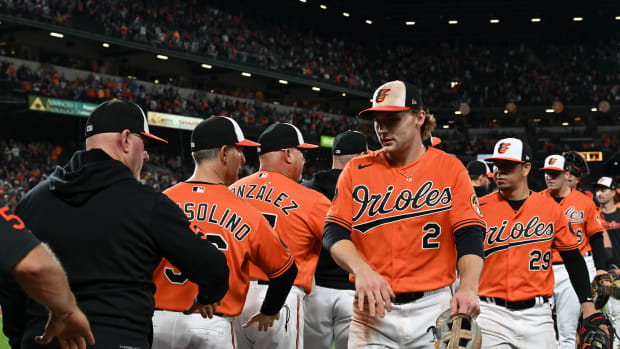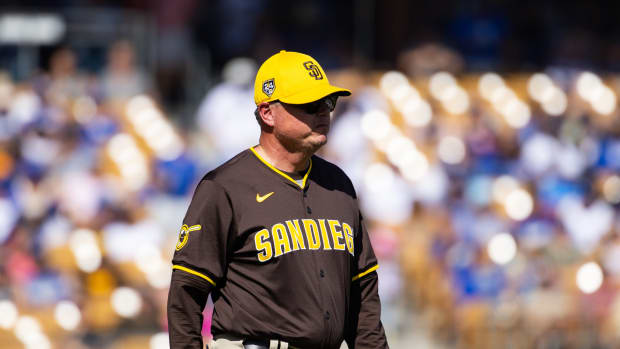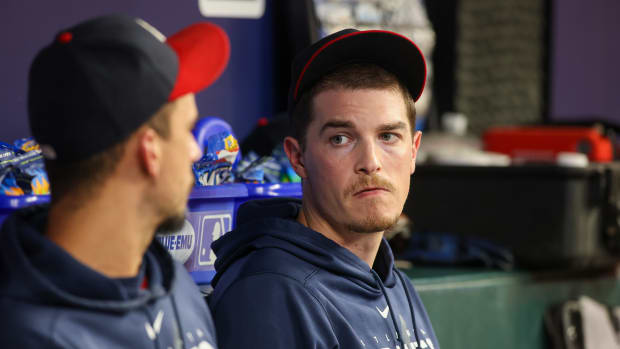What Is Yu Darvish Really Worth?
Yu Darvish's 2017 season ended in gruesome fashion. After two strong playoff starts for the Dodgers, the Astros battered him in Games 3 and 7 of the World Series, apparently because he was tippinghispitches. Nonetheless, the 31-year-old righty is arguably the top starting pitcher on the free agent market given Jake Arrieta's regression from his Cy Young form and the questions over how the since-signed Shohei Otani's stateside career will unfold. Reportedly, Darvish has narrowed his list of potential destinations down to six teams. While nobody has reported any dollar figures or hard offers, his status makes him an obvious candidate for my What's He Really Worth series.
Before coming stateside, Darvish spent seven seasons pitching for the Nippon Ham Fighters of the Japanese Pacific League, debuting when he was just 18 years old, throwing his first 200-inning season at age 20, twice winning ERA titles and MVP awards and adding an Eiji Sawamura Award for the NPB's top pitcher in either league. The Fighters agreed to post him to MLB after the 2011 season, and after winning his rights for a record $51.7 million, the Rangers signed the 25-year-old Darvish to a six-year, $60 million deal.
Seven Reasons Why the Free Agent Market Is So Incredibly Slow
Thanks to his elite fastball velocity and a deep arsenal of eight distinct pitches, Darvish quickly found success, turning in the best rookie season by a Japanese pitcher since Hideo Nomo in 1995. He went 16–9 with a 3.90 ERA (112 ERA+) and 221 strikeouts (fifth in the league) in 191 1/3 innings, good for 3.9 WAR, and finished third in the AL Rookie of the Year voting; some kid named Mike Trout won unanimously.
Darvish followed that up with his best season to date in terms of ERA (2.83, fourth in the AL), innings (209 2/3), strikeouts (a league-high 277) and WAR (5.8, fifth in the league). While 2014 featured his third-straight All-Star selection and strong rate stats, (3.06 ERA, 2.84 FIP, 11.3 K/9), that season ended in early August due to elbow inflammation. After lasting just one inning in his lone Cactus League start the following spring, it was discovered that he tore his UCL and needed Tommy John surgery.
By the time Darvish returned, on May 28, 2016, he had been absent from a major league mound for nearly 22 months. He made just three starts before going back to the disabled list for neck and shoulder discomfort, a stay that lasted five weeks. His numbers in 17 starts (3.41 ERA, 3.09 FIP, 11.8 K/9) were very much on par with his pre-surgery body of work, and he helped the Rangers return to the postseason for the first time since 2012, though his lone start against the Blue Jays in the Division Series was a dud.
Last year, the final one of his six-year deal, Darvish turned in his most complete season since 2013, throwing 186 2/3 innings, striking out 209 and finishing with a 3.86 ERA, 3.83 FIP and 3.9 WAR. While he didn't avoid the disabled list completely, the new 10-day minimum allowed him to miss one turn with what was termed lower back tightness but what was really a strategic break. By that point, Darvish had been traded to the Dodgers in a last-minute trade deadline deal on July 31. Prior to being dealt, Darivsh had generally pitched very well; the 10 runs he was lit up for in his 3 2/3-inning July 26 outing—his last as a Ranger, as it turned out — raised his ERA from 3.44 to 4.01, but the subsequent discovery that he had been tipping his pitches quelled concerns about his health. Having been placated by this explanation while doing their due diligence, the Dodgers should have been particularly attuned to the possibility of further tipping after his first World Series disaster; their failure to identify it may well have cost them a championship.
The Dodgers did help Darvish in other ways, however, using that late August DL stint to limit his workload, tweak his mechanics, simplify his repertoire and improve his sequencing. Though he was cuffed in his first two turns upon returning, he finished the regular season on a roll that carried through the NLCS. With greater reliance upon his cutter and slider at the expense of his four-seam fastball, he posted an 0.87 ERA with a 35/2 K/BB ratio in 31 innings over five starts. When the Astros spotted him changing his grip as he brought the ball into his glove, they could tell whether or not he was throwing a fastball.
The pitch-tipping mystery may be solved, but Darvish’s track record for health, with a Tommy John surgery and further shoulder problems, and overall mileage are worth noting for any suitor. Between NPB and MLB, he's thrown 2,000 2/3 regular season innings; among pitchers who have debuted since the 1994–95 strike, only Felix Hernandez (2,415 2/3), CC Sabathia (2,364 1/3), Javier Vazquez (2,062 1/3), Mark Buehrle (2061) and Jon Garland (2,029 1/3) threw more through their age-30 seasons. Sabathia's still going, having bookended two good seasons (2012 and '17) around four spotty, injury-riddled ones; he's averaged 1.7 WAR with a 104 ERA+ in his six seasons following that workload. Buehrle lasted six more seasons, averaging 3.0 WAR and 108 ERA+, albeit as a soft-tossing, contact-oriented lefty, a very different style of pitching than that of Darvish. Vazquez had one excellent season, two good ones and one bad one before disappearing from the majors after age 34, while Garland made just 21 more starts in his career. Hernandez managed just 86 2/3 innings in 2017, his first year since that cutoff, due to shoulder bursitis.
Grading the Deal: The Mets Make a Familiar, Boring Signing in Jay Bruce
That's not an especially encouraging group to compare Darvish to, nor is it a great fit for him, stylistically. A more relevant analogue may be Justin Verlander, a power pitcher who had 1,772 innings under his belt through 2013, his age-30 season. He's had ups and downs since, but has averaged 193 innings, a 116 ERA+ and 4.0 WAR in the four seasons since. Then again, he never underwent Tommy John surgery. All of which is to say that Darvish is in a rather unique spot.
As with Arrieta, Darvish's uneven track record makes for a fairly uninspiring first run through my WHRW model, which uses Tom Tango’s WARcel forecasting system, a WAR-based version of his Marcel the Monkey forecaster system ("the most basic forecasting system you can have, that uses as little intelligence as possible") that builds in regression and an aging curve as well. My WHRW model also uses research-based estimates of the cost of a win via free agency and the rate of salary inflation. The WARcel starts with a baseline forecast for the upcoming season using a 6/3/1 WAR weighting (six times the player's 2017 WAR plus three times his 2016 WAR plus his 2015 WAR, divided by 10) of the player's past three seasons and throws in a significant hit of regression (20% in the first year, or 0.8 times that weighted WAR). For pitchers older than 26, the aging curve is simply a baseline loss of 0.4 WAR per year, with no age-based acceleration as there is in the case of position players.
Using Darvish's rather modest Baseball-Reference WARs of zero (2015, his TJ season), 2.5 ('16) and 3.9 ('17), his 2018 baseline WAR of 3.1 gets cut down to 2.5 by the built-in regression, with subsequent seasons of 2.1, 1.7 and 1.3 for a net of just 7.5 WAR. Using the low-end estimate of $9 million per 2017 win and a 5.9% rate of inflation, that comes out to a valuation of $76.7 million over four years, the kind of contract that a healthy Darvish almost certainly wouldn’t sign. Casting that simplistic-but-useful mode of projection aside and going with a more advanced system, the well-regarded Steamer forecasts Darvish for 3.4 WAR via its RA9 flavor—that is, based on actual runs allowed (along the lines of Baseball-Reference’s version of pitching WAR) rather than based upon peripheral statistics (along the lines of FanGraphs’ version):
Year | Age | WAR | Market $/W | Value |
2018 | 31 | 3.4 | $9.53 | $32.4 |
2019 | 32 | 3.0 | $10.09 | $30.3 |
2020 | 33 | 2.6 | $10.69 | $27.8 |
2021 | 34 | 2.2 | $11.32 | $24.9 |
2022 | 35 | 1.8 | $11.99 | $21.6 |
2023 | 36 | 1.4 | $12.69 | $17.8 |
|
| 14.4 |
| $154.7 |
Individual pitcher performances don't tend to follow such linear patterns, of course, but for modeling purposes, it’s easier to think about in these terms rather than the reality of year-to-year fluctuation. Darvish’s performance doesn’t appear to be unattainable, particularly given his flashes of brilliance last year, which also included a 13-start run with a 2.83 ERA from early April to mid-June. I’ve gone to six years with run based on the industry expectations that Dodgers Digest's Dustin Nosler recently highlighted: those of FanGraphs' Dave Cameron (six years, $168 million), FanRag Sports' Jon Heyman (six years, $144 million), an unnamed—and allegedly more accurate—expert cited by Heyman (six years, $155 million) and MLB Trade Rumors (six years, $160 million).
Using the high-end estimate of $10.5 million per 2017 win puts Darvish’s valuation at $180.5 million over the six years; the $30.08 million average annual value would rank fourth among pitchers after the pacts of Zack Greinke ($34.417 million), David Price ($31 million) and Clayton Kershaw ($31.71 million), edging Max Scherzer ($30 million). I don’t think Darvish will get a deal quite that lucrative, but even the more conservative valuation above yields a $25.78 AAV, with only Scherzer and Jon Lester ($25.83 million) ahead of him and Justin Verlander ($25.71 million) right behind. It’s worth remembering that those contracts are all at least two years old, and timing is everything in that area. While the market is currently in stasis, its lack of depth in an industry that’s awash in cash—thanks to revenue having grown faster than salaries over the past decade (67% for the former, 52% for the latter according to Tom Verducci) and the sale of MLB Advanced Media to Disney (yielding a payout of roughly $50 million per team)—will likely produce eye-opening figures at the upper end.
Darvish is reportedly still considering six teams, namely the Astros, Cubs, Rangers, Twins, Yankees and, by his own account, a mystery team (believed to be the Dodgers). Neither the Yankees nor the Dodgers seem likely to go that high given their attempts to get under the $197 million Competitive Balance Tax threshold this winter, but that’s still plenty of competition to yield a contract in the ballpark of those two estimates.
Darvish’s history in MLB shows that a few glitches aside, when he’s has been available, he's been very good, producing 4.2 WAR per 180 innings. But as his own track record—and that of similarly hard-worked pitchers—illustrates, the odds of him staying on the field that long aren't high, and the mileage that his right arm has accumulated won't make doing so any easier. Like any pitcher he’s a risk and a costly one, but some team is certain to bite the bullet and go big.



































